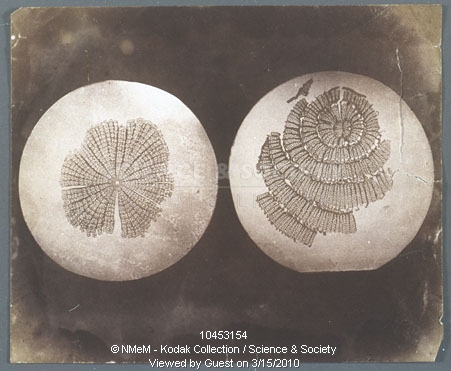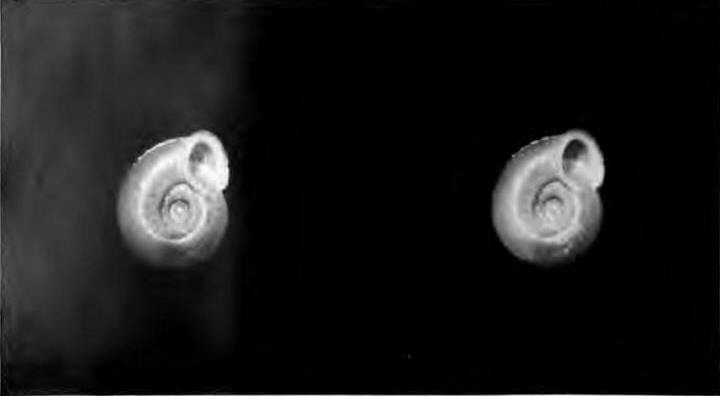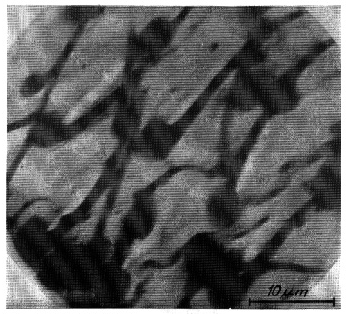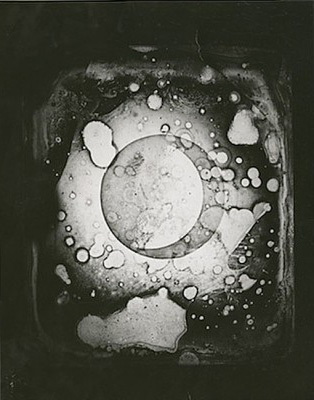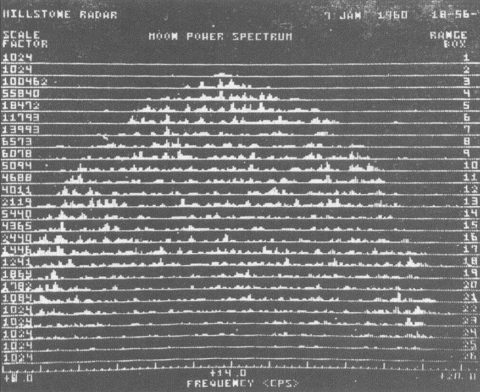First photomicrography, micro-cinematography, electron micrography, astrophotography, astro-cinematography, and radar & radio astronomy |
||
Photomicrography |
||
|
William Henry Fox Talbot (1800–1877) was taking photographs through a microscope as early as 1837 [Frizot], and the above is an example of a photomicrograph taken using the earliest process he used, photogenic drawing. This is picture ref. 10453154 in the Science & Society Picture Library, where it's not dated; as reproduced in Burbridge it's dated as c. 1840, but in Keller c. 1839, and in Jeffrey 1839 (Keller also reproduces a Talbot photomicrograph of diatoms, given the same date). It's known that photomicrographs were among the photogenic drawings Talbot exhibited at the Royal Institution in London on 25 July 1839; Talbot himself reported that these had included "some images formed by the Solar Microscope, viz. a slice of wood very highly magnified, exhibiting the pores of two kinds, one set much smaller than the other, and more numerous. Another Microscopic sketch, exhibiting the reticulations on the wing of an insect."
Stereoscopic photomicrographs were being taken by 1866, at which date one (above), of the snail Helix costata (by Armand Varroquier), was published in Albert Moitessier's La photographie appliquée aux recherches micrographiques. [Wasielewski]
|
||
|
|
||
Micro-cinematography (cinemicrography) |
||
|
Around 1890 Francis Martin Duncan (1873–1961) took serial
photographs of microscopic organisms and animated them by mounting
them in a Zoetrope. [McKernan] In 1891 Étienne-Jules Marey (1830–1904) employed his newly perfected chronophotographe to photograph infusoria through a microscope. [Tosi]
|
||
|
|
||
Electron micrography |
||
|
|
||
|
This image of the wing surface of the house fly was
the first published electron micrograph (Driest, E. and Mueller, H.
O.: Z. Wiss. Mikroskopie 52, 53-57 [1935]). The micrograph was
made by Heinz Otto Mueller, with the original 1933 microscope
designed by its inventor Ernest Ruska (1906–1988). The microscope, completed in November 1933, was in fact Ruska's second design, but there don't appear to be any surviving images taken by the first (which had been completed in August of the same year). [Ruska's Nobel lecture, 1986] 3D imagery using a scanning electron microscope was first achieved, by D.J. De Rosier and A. Klug in 1968, by means of combining projections from different angles of tilt using the Fourier transform, a mathematical technique. Initially this only worked with helically symmetrical structures, such as the tail of the T4 bacteriophage, on which it was first employed. [De Rosier & Klug, 3D Electron Microscopy] On 25 April 2012 a Japanese research group announced that they had developed a scanning electron microscope (SEM) capable of showing a 3D image in real time, with a high-resolution naked-eye 3D monitor for the SEM. [Tech-On]
|
||
|
|
||
Astrophotography |
||
|
Unsurprisingly, the first subject for astrophotography was the moon.
Louis-Jacques-Mandé Daguerre (1787–1851) made an unsuccessful
attempt at photographing the moon in 1839, but the long exposure
time resulted in a blurred image. [Ré,
Hughes]
John William Draper (1811–1882) succeeded in capturing a daguerreotype image of the moon, probably in late 1839. Although this survives, it is badly flawed with photographic artefacts and other imperfections, and can't be regarded as successful. Successful or not, this is the earliest known astrophotograph, and as such is the one I've chosen for reproduction here. He later made what is now regarded as the first successful daguerreotype of the moon (a 30-minute exposure), using a 3in lens and a 6in mirror. Draper reported his success to the New York Lyceum of Natural History on 23 March 1840. According to Stefan Hughes, Draper's first successful daguerreotype was destroyed in a fire at New York University in 1865, but a copy survives. [Ré; Hughes, p132, where the copy of the later, successful, image is also reproduced] [The first stereoscopic astrophotographs, of the Moon, were taken by Warren de la Rue (1815–1889) in 1858/9. The stereoscopic effect was achieved by taking left and right images at different librations, 15 months apart, so is really an artifice.]
|
||
|
|
||
Astro-cinematography |
||
|
The French astronomer Pierre-Jules-César Janssen (1824–1907)
developed what he called a 'photographic revolver' in 1873 (designed
by himself, but constructed by the Redier
technicians). On 8 December 1874 he and his colleagues, on an
expedition to Nagasaki, used it to record images of the transit of
Venus across the solar disc. Using a disc-shaped daguerreotype
plate, Janssen's colleague, the Brazilian astronomer Francisco
Antônio de Almeida, obtained 47 small
photographs of the solar edge, taken at intervals of approximately a
second. The photographic revolver, and what some thought was the plate concerned, are
exhibited at the Museum of the Conservatoire National des Arts et
Metiers (CNAM) in Paris. However, Françoise
Launay and Peter D. Hingley maintain that this is a practice plate,
and that not one of the revolver plates exposed during the transit
can now be traced. [Launay
and Hingley, Tosi,
Canales,
Ré,
Mourão; according to Rossell there were 48
images on each of four discs exposed that day.] Both Canales and Ré include images of the CNAM disc, and an animation was made from it by Joseph Leclerc in 1950 (possibly that now viewable on YouTube). (The Origins of Scientific Cinematography DVD includes an animation of a Janssen disc of the 1874 transit recorded by British astronomers, and a Quicktime animation has been made from glass-plate negatives taken by David P. Todd and his team of the 1882 transit. An animation also appears here but, despite the filename, this is probably not Janssen's disc.)
|
||
|
|
||
Radar astronomy |
||
| Radar astronomy, which explores distant objects by means of reflected microwaves, was developed from 1946 onwards. However, it was for some years too blunt an instrument to enable actual imaging. The first radar image—described as a 'range-Doppler' image—was of the Moon, obtained by Gordon Pettengill on 7 January 1960, using techniques developed by his colleague at MIT's Lincoln Laboratory, Paul Green. The top of the image (shown in range box 2) represents the point on the lunar surface closest to the radar. [Butrica] | ||
|
Photo no 261209-1D, courtesy of MIT Lincoln Laboratory, Lexington, Massachusetts |
||
|
|
||
Radio astronomy |
||
|
The first detection of an astronomical radio source was made by Karl
Jansky (1905–1950) in the early 1930s, and the first parabolic radio telescope
made by Grote Reber (1911–2002) in 1937. As single radio telescopes can't
achieve high resolution, a technique known as interferometry was
developed in 1946 by Martin Ryle, Joseph Lade Pawsey, and Ruby
Payne-Scott, using multiple telescopes. Present-day radio-astronomy, and the now familiar high-resolution computerised images, are dependent on what is called very long base interferometry (VLBI), which combines observations from many telescopes, emulating a single telescope of a size comparable to the maximum separation of the constituent telescopes. Although first demonstrated (by Roger Jennison) in 1958, it only became widely used in 1974. So far I have not succeeded in locating early examples of VLBI imagery. The earliest images in the Bordeaux VLBI Image Database date from 1994.
|
||
© 2010–2023 Benjamin S. Beck |
If you know of any suitable examples, please contact me.
|
|
